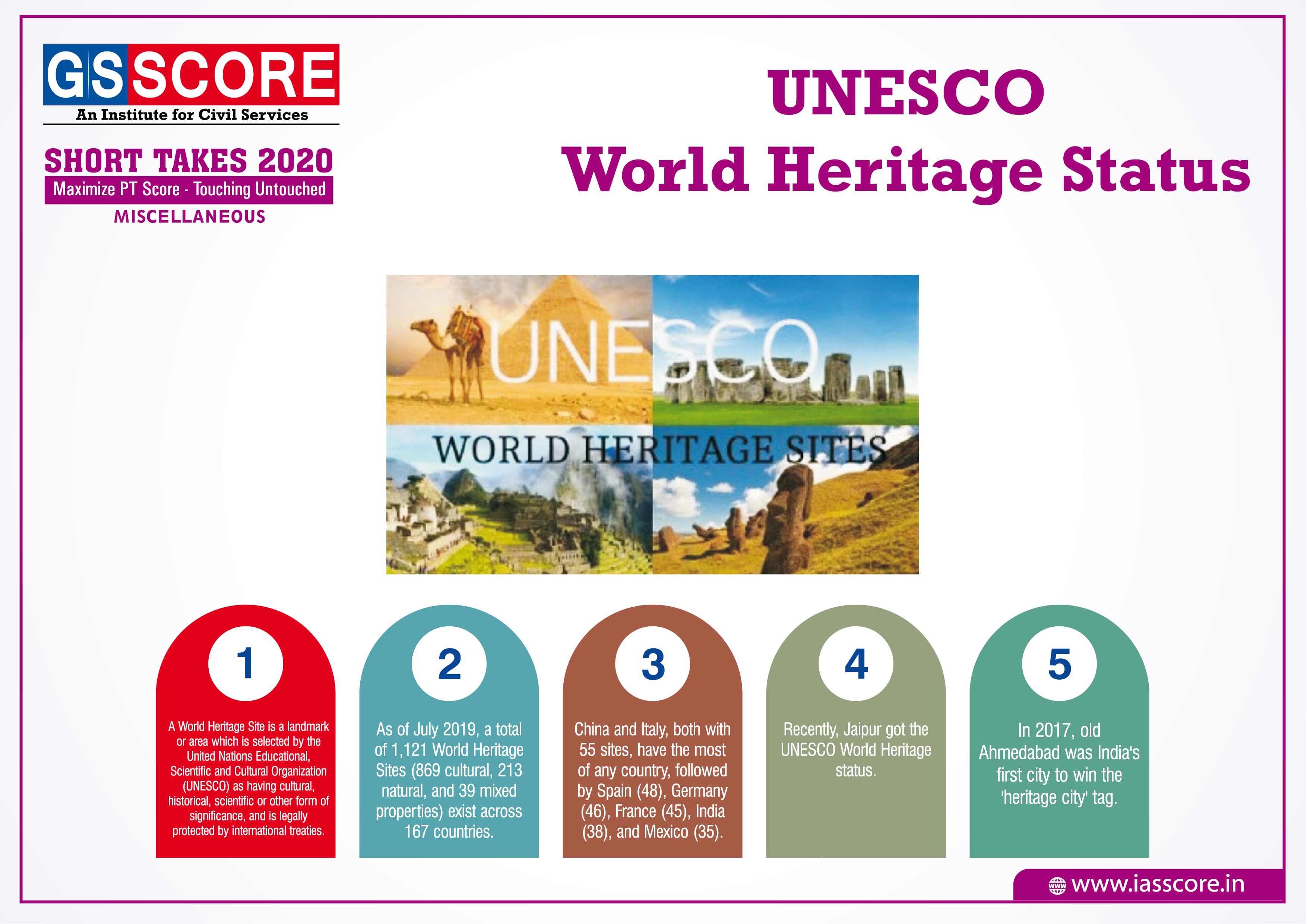Environment & Ecology: Ecosystem and its Dynamics
Ecosystem and its Dynamics
Environment
The environment is defined as ‘the sum total of living, nonliving components; influences and events, surrounding an organism’. Everything that surrounds or affects an organism during its life time is collectively known as its environment which comprises both living (biotic) and nonliving (abiotic) components.
Components of Environment:
- Abiotic Components: Soil, Topography, Water, Atmosphere etc.
- Biotic Components: Green Plants, Non-Green Plants, Animals, Parasites, Decomposers etc.
- The environment is not static. Both biotic and abiotic factors are in a flux and keep changing.
What is Biosphere?
- Biosphere is the life supporting layer which surrounds the earth and makes existence of life possible without any protective layer.
- The biosphere consists of living organisms, physical environment and energy. It is the zone of assemblage of lithosphere, atmosphere, hydrosphere and living organisms together.
- There are three components of biosphere, are:
- Biotic or organic components: It includes micro- organisms, plants and animals including man.
- Inorganic or abiotic component: It includes physical environment of soil, water, air, temperature and sunlight.
- Energy component: Solar and geothermal energy etc.
- Biosphere is termed as an open system as there is continuous inward and outward flow of energy and matter.
- Biosphere always tends to maintain equilibrium between flow of energy and output of the matter. If this equilibrium is maintained environmental and ecological balances are also maintained. Disturbances in the biosphere equilibrium bring ecological and environmental disturbances which have long term or short term effects on the very existence of living beings.
- Biosphere is affected and modified by certain factors directly or indirectly. These factors are called as modifiers. Three types of biosphere modifiers are known:
- Physical modifiers: They affect the biosphere by change in air quality, air flow, temperature changes, water flow, fire, excavation and construction works.
- Chemical modifiers: It alters the chemical composition of air, water and soil. It may be brought in due to multitude of pollutants.
- Biological modifiers: Biological factors like cropping patterns, population pressures, manipulations of species density or distribution and species genetics can also modify the biosphere equilibrium.
What is Ecology?
- Ecology deals with the inter-relationships amongst organisms and interactions between organisms and their environment. In other words, Ecology is the study of organism in relation with the surrounding in which they live. The surrounding is the environment of the living organisms and nonliving things in the vicinity.
- The term Ecology is being derived from two Greek words namely,’Oikos’ meaning home or place to live in and ‘logos’ means study. It means the study of the home of nature.
Types of Ecology
- Autecology/Species Ecology: The study of reciprocal relationships between every stage of development of a population/species and its environment is called autecology.
- Synecology: It is the study of reciprocal relationships between composition, organization and development of communities and their environment. Synecology is further divided into following:
- Population Ecology: Study of interactions of individuals- population of single species with each other.
- Community Ecology: The study of inter-relationships and inter-dependencies of groups of individuals of distinct species of plants, animals and micro-organisms together.
- Biome Ecology: The study of interactions and interrelationships of more than one biological community in various stages of succession under similar climatic condition of the area concerned in the study.
- Ecosystem Ecology: The study of interactions and inter-relationships of all organisms among themselves and with their environment.
- Habitat Ecology: Habitat is an ecological area which is inhabited by a species of living being. Habitat ecology studies variation in habitats in terms of their physical characteristics like topography, soils, insolation, temperature, water, minerals, weather and climate etc. Habitat ecology is further divided on the basis of different habitats and their mutual relationship with their inhabitants into forest ecology, grassland ecology, fresh water ecology, estuarine ecology, island ecology, marine ecology, coral reef ecology etc.
- Applied Ecology: It is the study of specialized field of ecology which are concerned with conservation and economic exploitation of organisms e.g., agronomy, agriculture, animal husbandry, forestry, wildlife management, conservation ecology, pollution ecology.
- Systems Ecology: Branch of ecology dealing with interpretation of ecological concepts and processes in terms of mathematical models and formulae.
- Genecology: Study of genetic composition and changes in relation to the origin of ecotypes, new species, etc.
- Social Ecology: It is a critical social theory of American socialist Murray Bookchin. It advocates a constructive and transformative outlook on current social and environmental issues. It suggests that the roots of the current ecological and social problems can be traced in the unordered modes of social organization. It says that apart from the natural disasters, majority of the concurrent ecological dislocations have ethnic, economic, cultural and gender conflicts among others. It also says that the present ecological problems cannot be resolved without dealing with the problems of society.
What is Ecosystem?
- An ecosystem is defined as a structural and functional unit of biosphere consisting of community of living beings and physical environment, both interacting and exchanging materials between them. Ecosystem is a self-contained, dynamic system composed of a natural community along with its physical environment.

Components of Ecosystem
The components of the ecosystem are divided as:
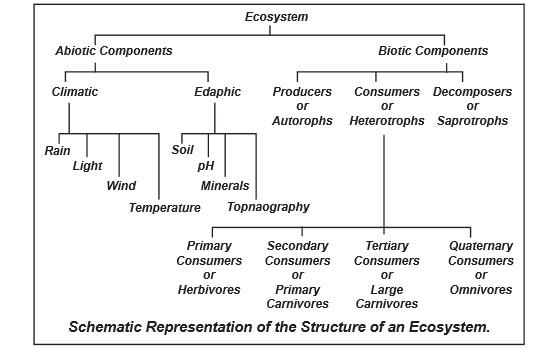
Abiotic Components:
Abiotic components are non-living chemical and physical factors on an ecosystem. The non-living factors are either resources or conditions. Important abiotic components can be listed as follows:
- Physical factors: They sustain and limit the growth of organisms in an ecosystem.
- Light: Light energy (sunlight) is the primary source of energy in nearly all ecosystems. It is the energy that is used by green plants (which contain chlorophyll) during the process of photosynthesis; a process during which plants manufacture organic substances by combining inorganic substances.
- Temperature: The distribution of plants and animals is greatly influenced by extremes in temperature.
- Water: The life on earth originated in water and is unsustainable without water.
- Atmospheric gases: The most important gases used by plants and animals are oxygen, carbon dioxide and nitrogen. Oxygen is used by all living organisms during respiration. Carbon dioxide is used by green plants during photosynthesis. Nitrogen is made available to plants by certain bacteria and through the action of lightning.
- Soil: Various characteristics of the soil such as soil composition, grain size and aggregation determine the percolation and water holding capacity of the soils. These characteristics along with parameters such as pH, mineral composition and topography determine to a large extent the vegetation in any area. This in turn dictates the type of animals that can be supported.
- Organic compounds: They are the building blocks of living systems and therefore, make a link between the biotic and abiotic components. Examples are: Carbohydrates, proteins, lipids and humus substances.
- Inorganic compounds: Such as carbon, carbon dioxide, sulphur, nitrates, phosphates and ions of other metals are necessary for survival.
Biotic Components
The biotic components in an ecosystem include the living organisms. They are grouped in to 3 classes based on the organism’s role in the flow of material and energy within the ecosystem:
- Producers (Autotrophs):
- Autotrophs produce organic compounds from carbon dioxide as a carbon source. They take energy from the sun (or from inorganic sources in some cases) to convert it into organic molecules or food, e.g., plants, algae, bacteria, etc.
- A portion of food synthesized, is used by autotrophs for their growth and other biological functions and remaining is stored for future use. This stored food in autotrophs is utilized as food by other organisms (called heterotrophs).
- Consumers (Heterotrophs):
- They are called heterotrophs and they consume food synthesized by the autotrophs. Based on food preferences they can be grouped into three broad categories:
- Herbivores (e.g. cow, deer and rabbit etc.) feed directly on plants, carnivores are animals which eat other animals (eg. lion, cat, dog etc.) and omnivores organisms feeding upon both plants and animals e.g. human, pigs and sparrow.
- Decomposers:
- Decomposers are organisms (often fungi or bacteria) that break down organic materials to gain nutrients and energy. Decomposition is a natural process but decomposers accelerate it. The role that decomposers perform in an ecosystem is extremely important.
- When an organism dies, it leaves behind nutrients that are locked together.
- Decomposers unlock these nutrient and release as raw nutrients (such as nitrogen, phosphorus, and magnesium) in a form which are usable for plants. Decomposers also convert organic carbon into Carbon dioxide, which can be trapped by photosynthesizers.
Ecological Succession
- Ecological Succession is the process by which a natural community moves, through a sequential change in the structure and composition, from a simpler level of organization to a more complex community.
- Succession is a long-term cumulative, directional and largely predictable process of natural development of different communities at the same site in a definite sequence over a period of time. Such changes occur either in response to an environmental change or induced by the intrinsic properties of the community itself.
- Succession continues till a community develops maximum equilibrium to the environment. It is called Climax Community.

Types of Succession
Ecological Successions have been described using several criteria. Accordingly, there are several types of succession.
Autogenic and Allogenic Succession
- When succession is brought by living inhabitants of that community is called Autogenic Succession, while changes brought by outside forces is known as Allogenic Succession.
Induced Succession
- Man has controlled succession in such a way as to obtain a managed steady state in which good amount of organic matter can be harvested. It is called induced succession. In induced succession, like agriculture, a young state is maintained by various types of inputs and protective measures.
Defected Succession
- It is a succession in which the vegetation does not pass through the normal stages of development but either adds or replaces a succession type, e.g., ABB’CDE or AB’CDE instead of the normal ABCDE.
Primary Succession
- It is the succession that takes on a primary bare area or an area which was not previously inhabited by plants. Such an area is biologically sterile and is, therefore, quite hostile in starting. Succession is also slow.
Secondary Succession
- It occurs on a site which has become bare secondarily due to destruction of previous vegetation. The area is biologically fertile and hence favourable for reappearance of plant life. Succession is quite rapid.
Autotrophic and Heterotrophic Succession
- Succession in which initially the green plants are much greater in quantity is known as Autotrophic Succession; and the ones in which the heterotrophs are in greater in quantity is known as Heterotrophic Succession.
Cyclic Succession
- A pattern of succession where the climax community is destroyed again and again and a similar pattern of secondary succession repeat itself every time.
The Process of Succession
- The characteristic sequence of the successional stages includes 8 elementary processes, namely:
- Nudation: It is the creation of bare area. Nudation can occur due to physiographic, climatic or biotic agents.
- Migration: Migration starts when gemmule moves from the parent area and arrives in a new area. A gemmule consists of reproductive structure like seed, spore or propagule. Migration is influenced by four factors–mobility, agent, distance and topography.
- Colonization: The nature of topography of the bare area also determines the type of the initial vegetation. For example, on bare rock only the spores of some cyanophytes or the soredia of lichens can stick and germinate while in a saline area only the seeds of some halophytes can grow. The first arrivals in a bare area are called Pioneers or pioneer colonizers. The occupation of a bare area by the pioneers and other invaders is called colonization.
- Ecesis: The establishment of plants in a new place is called ecesis. It consists of three processes- germination, growth and reproduction.
- Aggregation: It is the increase in number of the colonizing individuals. In the beginning the pioneers are few in number and grow far from one another. They produce a large number of disseminules which spread in the open areas and increase the number of pioneers. If invasion continues and the invaders are also able to multiply, the phenomenon is called Mixed Aggregation.
- Competition: It may be intra-specific (among individuals of the same species) or inter-specific (among individuals of the different species). Competition occurs when the availability of a necessity becomes inadequate to meet the optimum requirement of all the individuals growing in that area.
- Invasion: Various other types of plants try to establish in the space left by the elimination of plants due to competition.
- Reaction: It is the change brought about by colonizers in the habitats. The first reaction is localized. It consists of such changes as bindings of soil particles, assisting in weathering or building soil at the bottom of a water reservoir. Death of roots produces channels in the soil for quick absorption of rain water. Humus produced by the death of older or weak plants increases water retention, aeration and nutrition of the soil. The reaction of the early colonizers is such as to make the habitat less favourable to them and more favourable to invaders.
- Stabilization: Continuous competition invasion and reaction give rise to continuous changes in the environment and structure of vegetation. After a long interval some individuals arise which are in complete harmony with the climate of the area. This is termed as stabilization.
Ecotone
An ecotone is a zone of junction or a transition area between two biomes (diverse ecosystems). It is the zone where two communities meet and integrate. For e.g. the mangrove forests represent an ecotone between marine and terrestrial ecosystem.
Characteristics of Ecotone:
- It may be narrow (between grass-land and forest) or wide (between forest and desert).
- It has conditions intermediate to the adjacent ecosystems. Hence it is a zone of tension.
- It is linear as it shows progressive increase in species composition of one in-coming community and a simultaneous decrease in species of the other out-going adjoining community.
- A well-developed ecotone contains some organisms which are entirely different from that of the adjoining communities.
- Sometimes the number of species and the population density of some of the species are much greater in this zone than either community. This is called edge effect.
- The organisms which occur primarily or most abundantly in this zone are known as edge species. In the terrestrial ecosystems edge effect is especially applicable to birds. For example, the density of birds is greater in the ecotone between the forest and the desert.
Ecocline
- It is a zone of gradual but continuous change from one ecosystem to another when there is no sharp boundary between the two in terms of species composition.
- It occurs across the environmental gradient (gradual change in abiotic factors such as altitude, temperature (thermocline), salinity (halocline), depth, etc.).
Niche
- It refers to the unique functional role and position of a species in its habitat or ecosystem.
- The functional characteristics of a species in its habitat are referred to as “niche” in that common habitat.
- In nature, many species occupy the same habitat, but they perform different functions:
- Habitat niche – where it lives,
- Food niche – what is eats or decomposes & what species it competes with,
- Reproductive niche – how and when it reproduces,
- Physical & Chemical niche – temperature, land shape, land slope, humidity & another requirement.
- Niche plays an important role in the conservation of organisms. If we have to conserve species in its native habitat, we should have knowledge about the niche requirements of the species.
FUNCTIONS OF AN ECOSYSTEM
The function of an ecosystem is a broad, vast and complete dynamic system.
It can be studied under the following three heads:
- Energy flow
- Nutrient cycling (Biogeochemical cycles)
- Ecological succession or ecosystem development
Energy Flow
- Energy is the basic force responsible for all metabolic activities.
- The flow of energy from producer to top consumers is called energy flow which is unidirectional.
- Energy flows through the trophic levels: from producers to subsequent trophic levels.
- There is a loss of some energy in the form of unusable heat at each trophic level.
- The trophic level interaction involves three concepts namely:
- Food Chain
- Food Web
- Ecological Pyramids
Food Chain
- The unidirectional transfer of food energy from the producers, through a series of organisms (herbivores to carnivores to decomposers) with repeated eating and being eaten, is known as food chain. It is the movement of organic matter and energy from the producer level through various consumer levels.
- The various steps in a food chain are called trophic levels and transfer of energy in term of food from one trophic level to another is called energy flow. Energy flow is always unidirectional.
Types of Food Chains
Grazing Food Chain
- It is the most common food chain. It is also called predator food chain as predation occurs at every step.
- The consumers which start the food chain, utilizing the plant or plant part as their food, constitute the grazing food chain. This food chain begins from green plants at the base and the primary consumer is herbivore.
Detritus Food Chain
- It begins with detritus or dead organic matter.
- The food energy present in detritus passes into detrivores and decomposers who feed over it.
- Detrivores and decomposers are consumed by smaller carnivores which in turn become food for larger carnivores and so on.
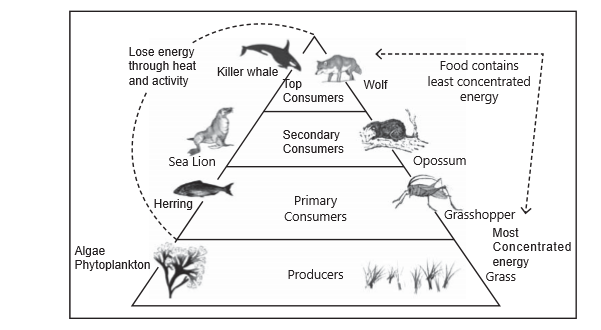
Flow of energy in the Food Chain
- Flow of energy in an ecosystem is always unidirectional or one way that is, it passes from solar radiations to producers, then to herbivores and then to carnivores and omnivores. As there is gradual increase in the trophic level of food chain, there is decrease in the content and flow of energy. This happens because:
- 20% of the energy captured by producers is dissipated in respiration and metabolic activity.
- Rest energy stored in producers goes down to herbivores in the form of food through food chain.
- In the herbivores, a lot of the energy assimilated from the food is dissipated in ingestion and digestion of food, respiration and metabolism, body functions, egestion and heat. Only 10% of this energy is stored by herbivores in the form of building material of body.
- Herbivores are eaten by carnivores; the 10% stored energy of herbivores goes down to carnivores. Carnivores dissipate a majority of this assimilated energy in digestion, respiration, body functions and heat. Only 10% of the energy is stored in carnivores.
- Higher carnivores and omnivores are similarly able to store only 10% of the carnivores’ energy.
- Hence flow of energy in a food chain follows a Ten Percent Law. This was proposed by Lindeman in 1942.
Food Web
- Simple food chains are very rare in nature because each organism may obtain food from more than one trophic level. Thus in an ecosystem, the various food chains are interconnected to each other to form a network called food web. The concept of food web was introduced by Charles Elton in 1927.
- A food web illustrates all possible transfers of energy and nutrients among the organisms in an ecosystem, whereas a food chain traces only one pathway of the food. Food webs are very important in maintaining the stability of an ecosystem.
Composition of Food Web
- A food web operates according to food preferences of the organisms at each trophic level. However, availability of food source and other compulsions are equally important. In Sunderbans, the tigers eat fish and crab in the absence of their natural preys.
- Some organism normally operates at more than one trophic level. Thus human beings are not only herbivores but also carnivores of various levels. Jackals are both carnivores and scavengers. Snakes feed on mice (herbivores) as well as frogs (carnivores). Wild cats prey upon mice as well as birds and squirrels. A wolf eats fox as well as rabbit and deer.
Ecological Pyramids
Ecological pyramids are the graphic representations of trophic levels in an ecosystem. The producers make the base of the pyramid and the subsequent tiers of the pyramid represent herbivore, carnivore and top carnivore levels. They are pyramidal in shape and they are of three types:
Pyramid of Energy
- The pyramid of energy or the energy pyramid describes the overall nature of the ecosystem. During the flow of energy from organism to other, there is considerable loss of energy in the form of heat. The primary producers like the autotrophs there is more amount of energy available. The least energy is available in the tertiary consumers. Thus, shorter food chain has more amount of energy available even at the highest trophic level.
- The energy pyramid always upright and vertical.
- An energy pyramid reflects the laws of thermodynamics with the conversion of solar energy to chemical energy and heat energy at each trophic level and with the loss of energy being depicted at each transfer to another trophic level. Hence the pyramid is always upward, with large energy base at the bottom.

Pyramid of Numbers
- It is a graphic representation of the number of individuals per unit area of various trophic levels stepwise with producers being kept at the base and top carnivores kept at the tip. In most cases, the pyramid of number is upright with members of successive higher trophic level being less than the previous one.
- The maximum number of individuals occurs at the producer level. The producers support comparatively fewer numbers of herbivores, the latter fewer number of primary carnivores and so on. Top carnivores are very few in number.
- In grassland, a larger number of grass plants or herbs support a fewer number of grasshoppers that support a still smaller number of frogs, the latter still smaller number of snakes and the snakes support very few peacocks or falcons.
- A similar case is found in a pond ecosystem where a large number phytoplankton support comparatively smaller number of zooplanktons the latter fewer number of small-sized fishes, the small-sized fishes become food of still fewer larger-sized fishes or water birds.
- The number of pyramids in a higher trophic level is generally smaller than that of the lower trophic level because the organisms of the higher trophic level are dependent for their food and energy on the organisms of the lower trophic level.
Pyramid of Numbers Inverted
- In this pyramid, the number of individuals is increased from lower level to higher trophic level. E.g. Tree ecosystem.

Pyramid of Biomass
- Pyramid of biomass is usually determined by collecting all organisms occupying each trophic level separately and measuring their dry weight.
- This overcomes the size difference problem because all kinds of organisms at a trophic level are weighed.
- Each trophic level has a certain mass of living material at a particular time called the standing crop.
- The standing crop is measured as the mass of living organisms (biomass) or the number in a unit area
Pyramid of Biomass – upright
- For most ecosystems on land, the pyramid of biomass has a large base of primary producers with a smaller trophic level perched on top.
- The biomass of producers (autotrophs) is at the maximum. The biomass of next trophic level i.e. primary consumers is less than the producers. The biomass of next higher trophic level i.e. secondary consumers is less than the primary consumers. The top, high trophic level has very less amount of biomass.
Pyramid of Biomass – Inverted
- In contrast, in many aquatic ecosystems, the pyramid of biomass may assume an inverted form. (In contrast, a pyramid of numbers for the aquatic ecosystem is upright)
- This is because the producers are tiny phytoplankton that grows and reproduces rapidly.
- Here, the pyramid of biomass has a small base, with the consumer biomass at any instant exceeding the producer biomass and the pyramid assumes an inverted shape.

Bioaccumulation
- It is the process of accumulation of persistent and toxic substances or chemicals in an organism.
- It occurs when any substance assimilated by any organism does not get metabolised or egested at the equivalent rate of its absorption.
- This is usually seen with substances with higher biological self-life like pesticides, insecticides and other persistent non- degradable pollutants.
- The longer the self-life of the substance, the greater would be the risk poisoning from the substance, even if the level of substance in the surrounding is under control.
Examples of Bioaccumulation
- Accumulation of the mercury used in industrial processes of the stiffening of the hats in the brain cells of humans caused Mercury poisoning.
- Accumulation of strontium-90 in the atomic bomb affected areas where it causes problems in bone formation.
- Eating of coastal fishes in heavily polluted area can lead to accumulation of heavy metals in the human body
Biomagnification
- It is a phenomenon of gradual increase in the concentration of chemicals and toxic substances accumulated in the tissues of organisms at successively higher trophic levels of food chain. It refers to a process where persistent pollutants like pesticides and heavy metals move up in the food chain and get accumulated at the top most trophic level of the food chain.
Process of Biomagnification
- Pesticides like DDT and other industrial pollutants like mercury etc. degrade very slowly in the ecosystem, thus these substances remain for a longer time and interfere with the dynamics of food chain.
- These substances are washed away from agricultural field or from water bodies and get accumulated on the producers of the food chain.
- Since these are slow metabolizing, so they are transferred from one trophic level to other with the biomass.
- As in a food chain, the number of individual decrease per trophic level successively so, the net amount of these persistent substances per individual keeps on increasing successively with the higher trophic levels of food chain.
- In this way, the maximum bioaccumulation of these persistent pollutants is seen at the top most trophic level of the food chain, this gradual increase in the relative amount of persistent pollutants per individual in any food chain with successive trophic levels is Biomagnification.
- The increase in concentration is due to
- Persistent nature of pollutants
- Food chain dynamics
- Slow rate of degradation of certain substances
- Due to biomagnification, worst impacts of pollutants are seen in the top most consumers or secondary carnivore or omnivore in a food chain. These top consumers include Humans, Tigers, Vultures etc.
Examples of Biomagnification
- The great Indian Bengal Vultures are pushed to extinction due to bioaccumulation and biomagnification of anti-inflammatory Drug Diclofenac. Diclofenac entered in the vulture’s food chain from humans and beef industries. Diclofenac is excessively used in Dairies to counter the effects of oxytocin. Oxytocin is a human hormone which helps in child birth and milk production. It is inappropriately used in dairies to induce milking, with extreme abdominal as a side effect. Diclofenac injected frequently in cattle to counter pain gets accumulated in cattle’s and is transferred to vultures from beef remains.
- Maximum accumulation of agricultural pesticide and insecticide DDT, DDE etc. is seen in Humans
Kerala to curb alien plants’ growth in NBR’
Context
The Forest and Wildlife Department is planning to adopt steps to arrest the rampant growth of invasive plants, especially Senna spectabilis, in the forest areas of the Nilgiri Biosphere Reserve (NBR), including the Wayanad Wildlife Sanctuary.
About
The need:
- The spread of invasive plants, especially Senna spectabilis, is posing a major threat to the forest areas of the reserve, owing to its quick growth and coppicing character.
- Invading larger areas: A recent study of the Ferns Nature Conservation Society recorded the presence of the plant in 78.91 sq km area of the sanctuary. The tree species was found in nearly 10 sq km area of the 344.44 sq km sanctuary around five years ago. Now, it had invaded to more than 50 sq km of the sanctuary.
- Emerging as a trap for open lands: Due to mass flowering and drying of bamboo species in Wayanad, lots of open spaces were created which had been occupied by Senna spectabilis. The vayal ecosystem (marshy land) of the forest area now has this plant in large numbers.
- Threat to tiger reserves: With the adjacent tiger reserves (Bandipur and Nagarhole tiger reserves in Karnataka and the Mudumalai tiger reserve in Tamil Nadu) also under threat.
What are the Invasive alien species?
- Invasive alien species are plants, animals, pathogens and other organisms that are non-native to an ecosystem, and which may cause economic or environmental harm or adversely affect human health.
- In particular, they impact adversely upon biodiversity, including decline or elimination of native species - through competition, predation, or transmission of pathogens - and the disruption of local ecosystems and ecosystem functions.
- In 2016, the Zoological Survey of India (ZSI) has for the first time compiled a list of 157 alien invasive animal species.
- Out of the total species, 99 are found in the marine ecosystem, while 58 are found on land and in freshwater habitat.
- The species found on land and in freshwater comprise of 19 fish species, 31 species of anthropods, 3 of molluscs and birds, 2 of mammals and 1 of reptile.
- Among 99 alien invasive marine species, genus Ascidia accounts for maximum number of species (31), followed by Arthropods (26), Annelids (16), Cnidarian (11), Bryzoans (6), Molluscs (5), Ctenophora (3), and Entoprocta (1).
- Some important species include: African apple snail (Achatina fulica), Papaya Mealy Bug (Paracoccus marginatus), Cotton Mealy Bug (Phenacoccus solenopsis), Amazon sailfin catfish (Pterygoplichthys pardalis) and others.
Senna Spectabilis:
- Senna spectabilis is a medium to large tree from tropical America, listed in the Global Compendium of Weeds as an ‘environmental weed’, ‘garden thug’, and ‘naturalised weed’.
- The species is extremely fast-growing, flowers and sets seed profusely, and re-sprouts readily when cut.
- An adult tree grows up to 15 to 20 metres in a short period of time and every year distributes thousands of seeds after gregarious flowering.
- The thick foliage arrests the growth of other indigenous tree and grass species and causes food shortage for the wildlife population, especially herbivores.
Why alien plants are so dangerous?
- Greatest threat to biodiversity: Invasive alien species, introduced and/or spread outside their natural habitats, have affected native biodiversity in almost every ecosystem type on earth and are one of the greatest threats to biodiversity.
- Contributor to animal extinction: Since the 17th century, invasive alien species have contributed to nearly 40% of all animal extinctions for which the cause is known (CBD, 2006).
- Problem for ecology and economy: The problem continues to grow at great socio-economic, health and ecological cost around the world. Invasive alien species exacerbate poverty and threaten development through their impact on agriculture, forestry, fisheries and natural systems, which are an important basis of peoples’ livelihoods in developing countries.
- This damage is aggravated by climate change, pollution, habitat loss and human-induced disturbance.
India Climate Report 2019
Context
Recently, India Meteorological Department (IMD) has released India Climate Report 2019.
About
- The India climate report 2019 confirms that the extreme weather events have become par for the course in the country.
- This is what climate scientists have been claiming for more than half a decade.
- It notes that excessive heat, cold and rainfall killed 1,562 people in 2019.
- In 2019, the mean temperature was 0.36 above normalwhile the country also recorded excess rainfall during both the southwest and northeast monsoons.
- Intense dry spells were interspersed with floods in several parts of the country.
- This is a phenomenon that policymakers will increasingly be called to factor while drawing up projects in areas as diverse as agriculture, urban planning, water resources and disaster management.
- The IMD report should be seen in conjunction with long-term meteorological trends.
- The World Meteorological Organisation, for example, reckons that the decade starting 2011 remains on track to be the warmest on record.
- At the same time, data from the European Centre for Medium Range Forecast shows that the relative humidity in the mid-troposphere in the Subcontinent has increased by about 2% in the past four decades.
- Such warming has increased the capacity of oceans to form intense cyclonic disturbances.
Causes of India’s vulnerability to Climate Risk
- India’s increasing vulnerability is due to severe rainfall, heavy flooding and landslide.
- The state of Kerala was especially impacted. The floods were described as the worst of the last 100 years.
- India was struck by two cyclones in October and November 2018 that also nearly killed 1,000 people.
- India also suffered from extreme heat. While human death toll was kept considerably low due to public measures, the economic damages were quite severe
What needs to be done?
- Increasing their resilience calls for efficient rainwater storage and use.
- The changing dynamics of weather also demand cooperation between states that share a river basin.
- This year, Maharashtra and Karnataka debated over opening the gates of the Almatti dam on the Krishna. By the time the two states agreed over the amount of water to be discharged from the dam, the damage was already done.
Conclusion
- It’s clear that dealing with exceptional weather will require interventions at the national, state and local levels.
- The Statement on Climate of India 2019 drives home the urgency of such interventions.
- However, there is still no specific UN climate finance facility to reimburse the loss of land, culture and human lives.
- So far, the industrialised countries have refused to even negotiate it in 2019 Climate summit (CoP 25) at Madrid recently.
- The word climate body must wake up in establishing a financial facility to reimburse the loss of land, culture and human lives due to climate change.
Global Marine Ecosystem Meet in Kochi
Context
Recently, the third international conference on Marine Ecosystems-Challenges and Opportunities (MECOS) was held in Kochi in January, 2019.
About
- The conference is aimed at reviewing the concerns involved in marine ecosystem and formulating strategies for the better and sustainable utilisation of marine wealth by enhancing livelihood options.
- The symposium is organized by the Marine Biological Association of India.
- It will also serve as a platform for discussions on a range of topics, including the impact of the climate crisis on marine ecosystems and an unusual warming of the Arabian Sea.
- The conference would focus on the Sustainable Development Goal of the United Nations, SDG-14 which says ‘conserve and sustainably use the oceans and its resources for sustainable development’.
Significance
- Healthy oceans, coasts and related ecosystems are crucial for economic growth and food production.
- Billions of people worldwide, especially the world’s poorest rely on healthy oceans to provide jobs and food underscoring the urgent need to sustainably use and protect this natural resource.
- However, numerous issues such as depletion of resources, marine pollution, extreme weather conditions and rising sea surface temperature pose a threat to the sustainable utilisation of marine resources.
- Hence, the conference would come up with a roadmap to deal with these issues.
Conclusion
- Eminent marine scientists, oceanographers, fishery researchers and marine bio-technologists from across the globe has assembled in Kochi and stressed the need for the preservation or marine ecosystem.
- Moreover, the symposium itself has been designed in an eco-friendly way.
- No printed materials and single-use plastics will be used at the symposium.
- Natural materials will be used for presenting mementos to the guests and certificates will be sent to the participants in digital form.
- This will have stronger impact on the behavior of people as well the state and non-state actors to play a major role in marine ecosystem conservation.
Ambubachi Mela
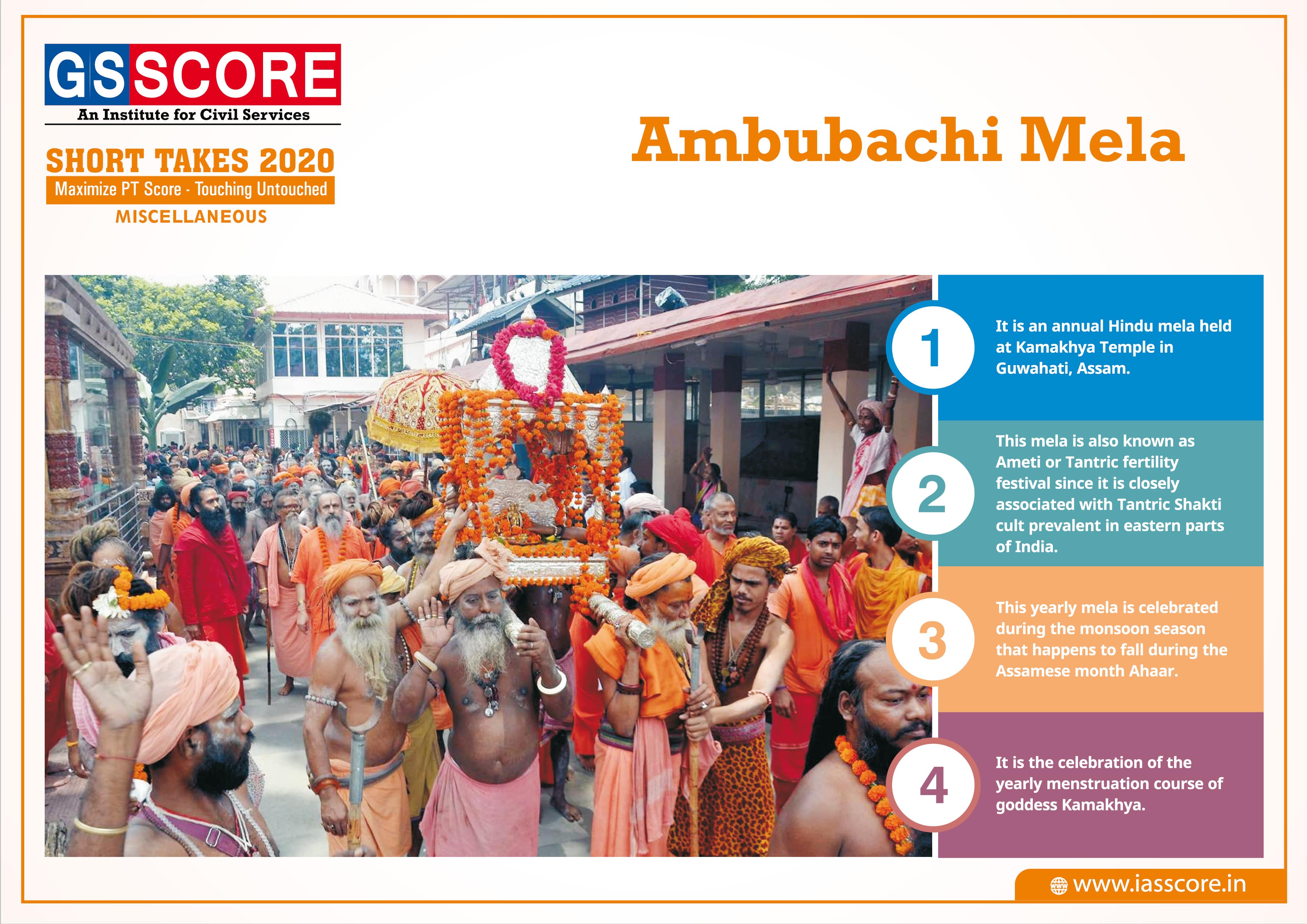
Kheer Bhawani Mela
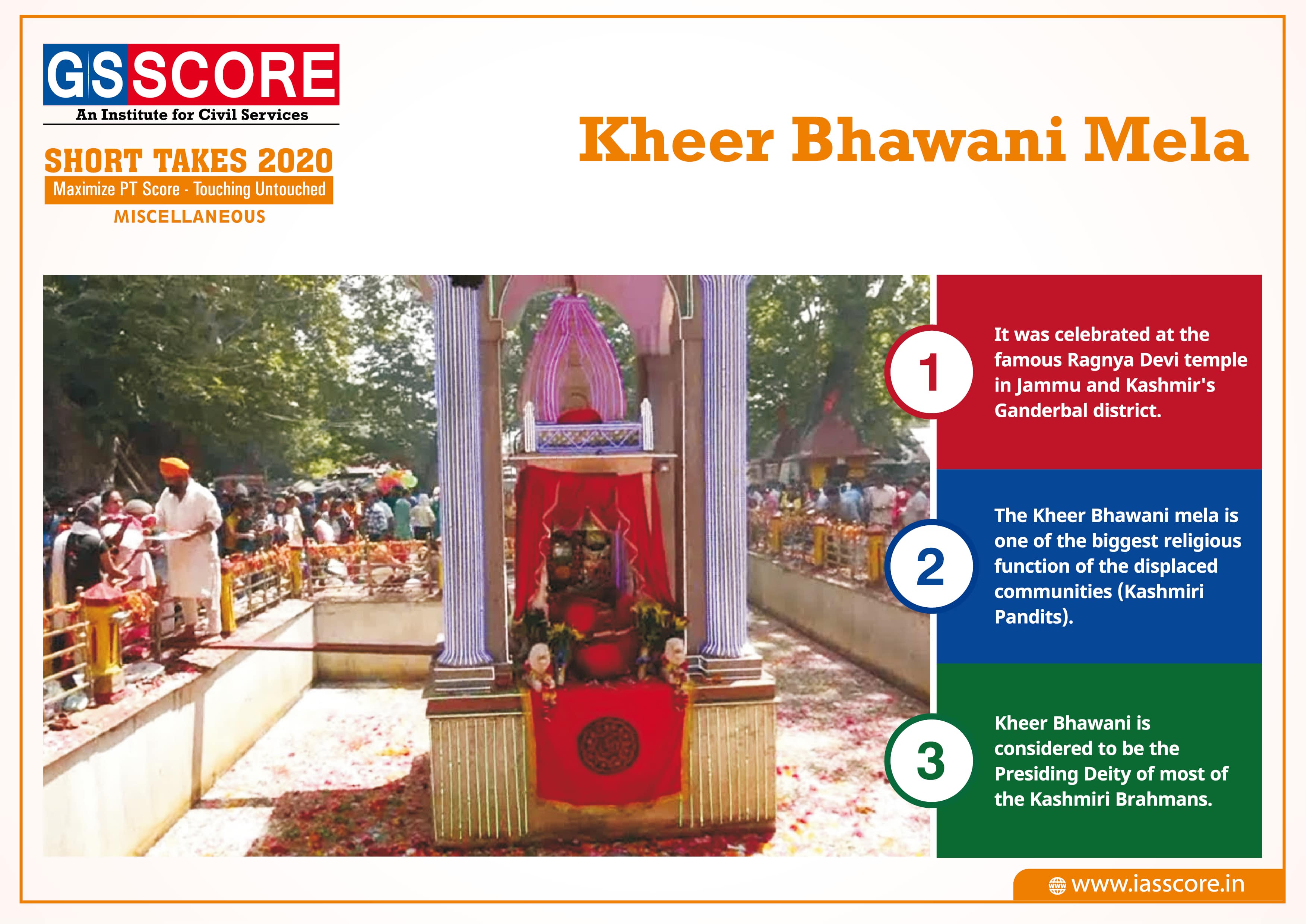
Swadesh Darshan Scheme
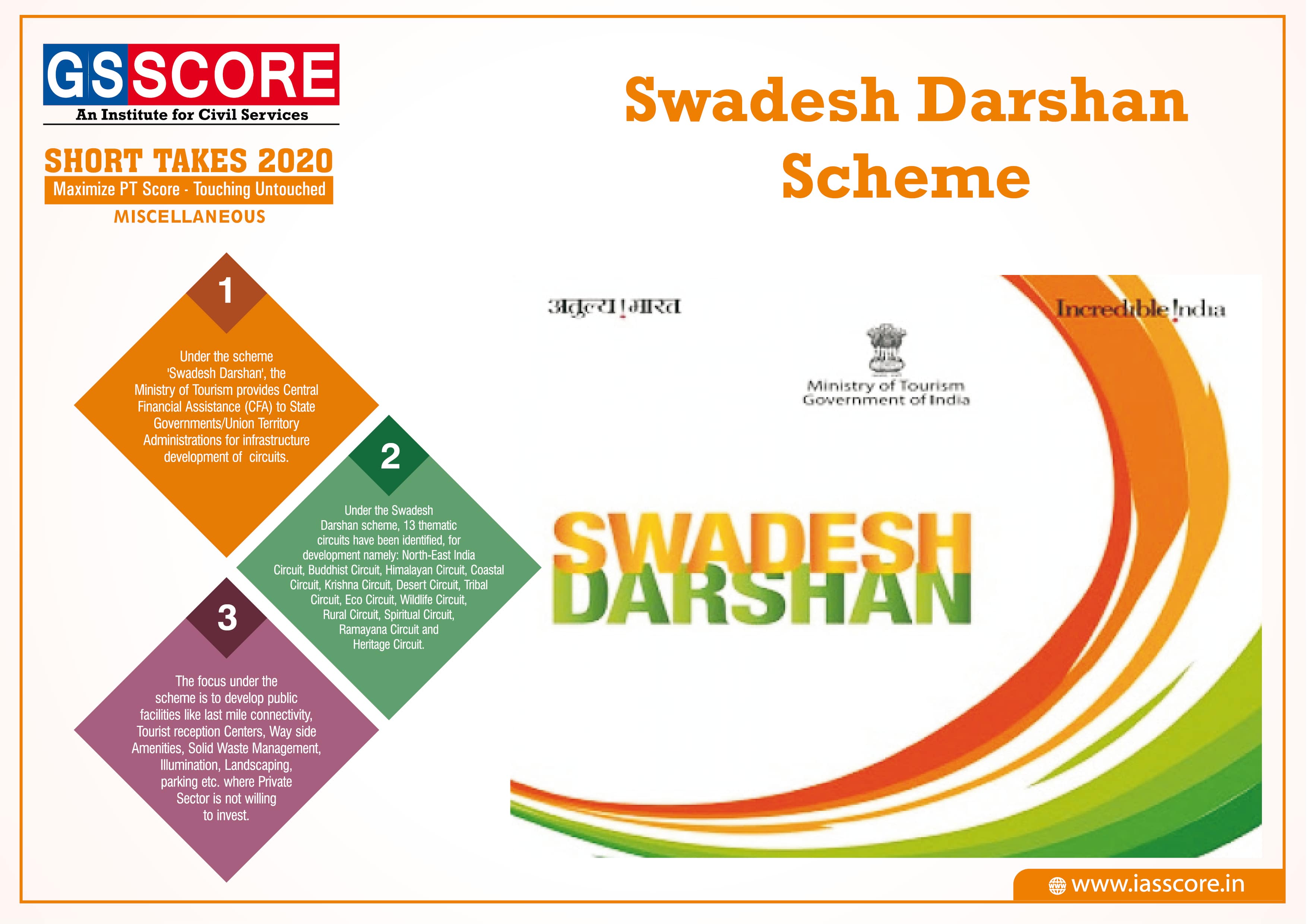
Markandeshwar group of Temples
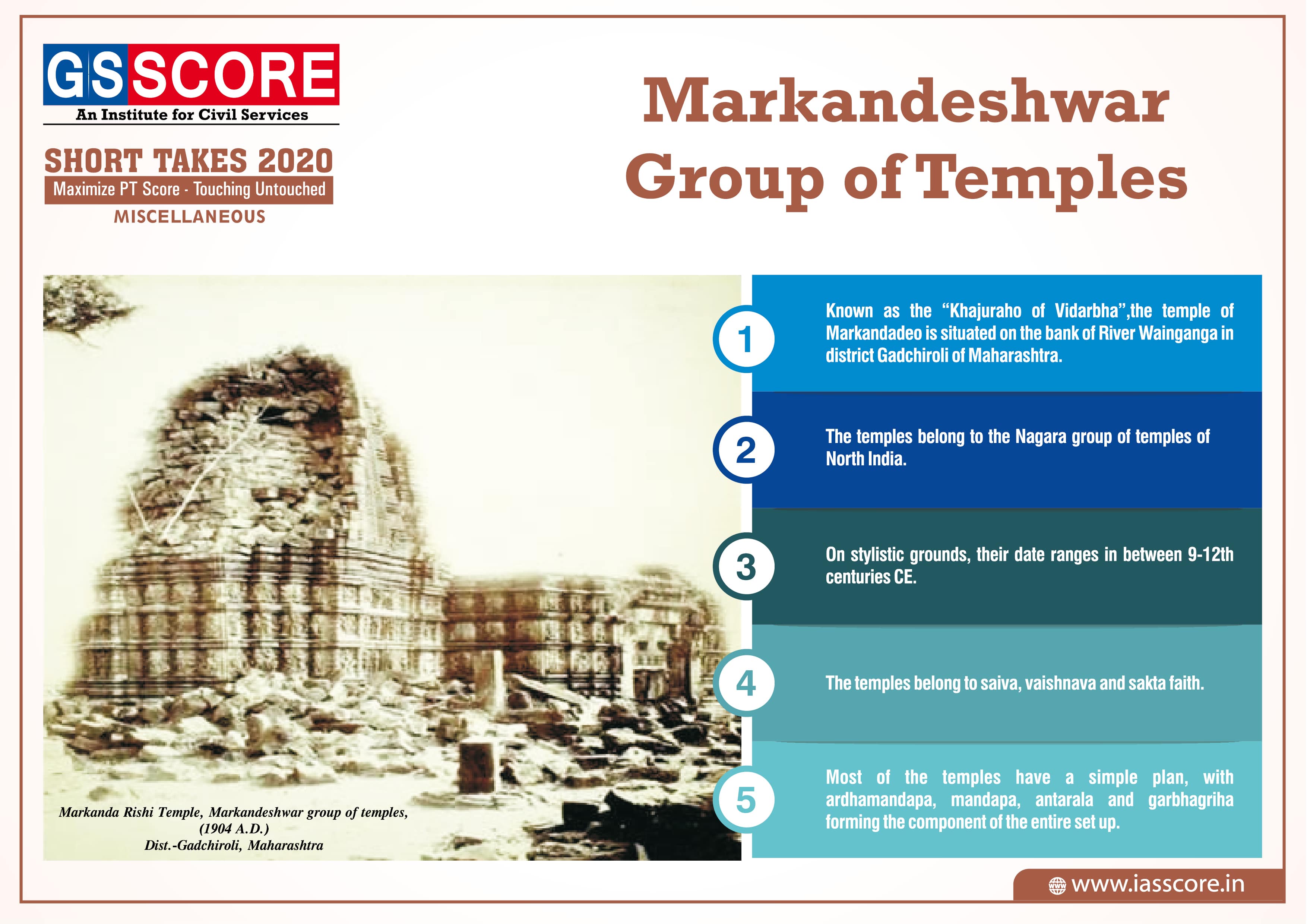
UNESCO World Heritage Status
